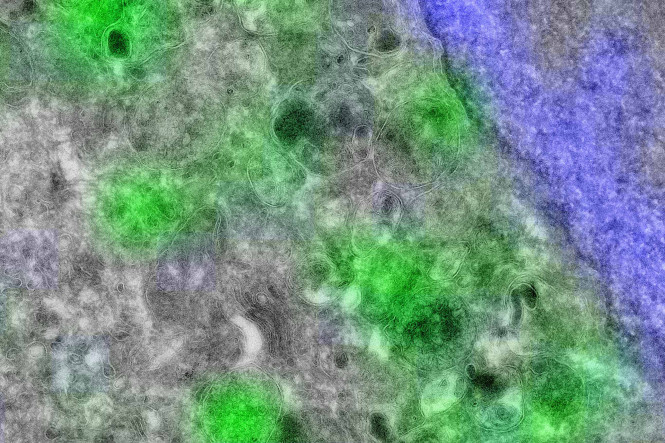A collaboration between several groups within the department of Cell and Chemical Biology showed that deubiquination enzyme ubiquitin-specific protease 32 (USP32) is a powerful new regulator in the endosomal system's architecture and function. The EM department visualized cellular structures using correlative light and electron microscopy methods.
The endocytic pathway guards cellular homeostasis through regulated disposal of harmful materials and nutrient recycling and operates via a network of vesicles called endosomes. The endosomal network remains mysterious in a number of ways and mechanisms underlying recycling pathways integral to selective proteolysis and maintenance of integrity are unclear and it is unknown how e.g. endosomes regulate between anterograde transport and recycling. Aiming to decipher this question, it was considered whether ubiquitin dynamics at the multi vesicular body membrane might be involved. Post-translational modifications with ubiquitin are known to regulate ESCRT-mediated cargo sorting and ESCRT complexes. Furthermore, Rab7 ubiquitination by Parkin has recently been shown to promote association of the retromer and extension of tubules from the limiting membrane of the MVB, suggesting that modification of Rab GTPases with ubiquitin may influence key decisions at the MVB. To dissect possible mechanisms of such spatiotemporal control, we performed a depletion screen for DUBs affecting LE architecture, revealing USP32 as a top new candidate of interest.
Using proteome-wide ubiquitin remnant profiling it is found that Rab7 is a key substrate of USP32 in this context and proposed that, by virtue of its catalytic activity, this DUB promotes retromer-mediated recycling from the MVB.Using SILAC-based ubiquitome profiling the small GTPase Rab7 is identified as a crucial substrate of USP32. Loss of USP32 causes dispersion and swelling of Rab7-positive vesicles and inhibits retromer complex-mediated recycling of cargos from the late endosomal compartment. These aberrations can, in turn, be efficiently rescued with wild type, but not catalytically inactive USP32, indicating an important role for reversible ubiquitination of Rab7 in cargo retrieval and maintenance of late endosome integrity.
